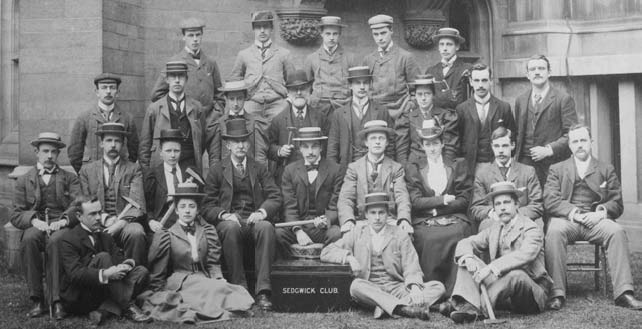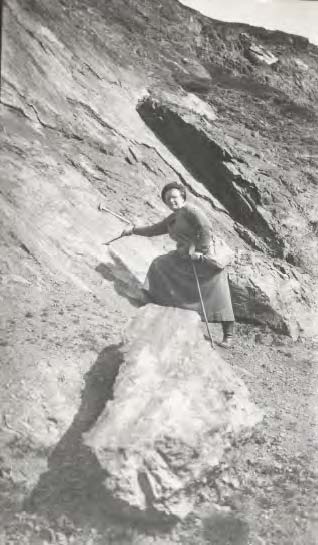Pioneering palaeontologist, geologist and woman of science
As reported in the last issue of Palaeontology Newsletter, the Association has introduced a new award for public engagement, which Council has decided should be named in honour of the pioneering palaeontologist Gertrude Elles (1872–1960). Principally known for her work on graptolites and Lower Palaeozoic stratigraphy, Elles was a pioneer in many respects. She was one of the first female lecturers at the University of Cambridge; the first female Reader at the University; a recipient of the Lyell Fund of the Geological Society in 1900; the first female recipient of the Murchison Medal of the Geological Society (1919); and the first female Council member of the Geological Society (1923–1927). Indeed, when awarded the Lyell Fund women were still not allowed to attend meetings of the Geological Society so she was unable to collect it in person and it had to be collected on her behalf by a man. Within twenty years, and a few months after being awarded the Murchison Medal, she was in the first group of twelve women admitted as Fellows of the Geological Society. Not restricting her activities to geology, she was the Red Cross commandant of a hospital for soldiers during World War One, for which she was appointed an MBE in 1920. At Newnham College, Cambridge, she was successively Demonstrator, University Lecturer, Director of Natural Science, and Vice-Principal (1925–1936). Pertinently in relation to the Association’s new award, Elles was President of the British Association for the Advancement of Science in 1923 (now the British Science Association).

Gertrude Elles was born in Wimbledon, then in Surrey, in October 1872. She went up to Cambridge in 1891 to read Natural Sciences, where she was influenced by the teaching of T. McKenny Hughes and J. E. Marr, graduating with First Class Honours in 1895. She stayed in Newnham College and began to undertake research on graptolites in the Woodwardian Museum. After a scholarship that enabled her to spend time in Lund, from 1895–1897, she began working with her Newnham friend Ethel Wood (later Dame Ethel Shakespear) and Charles Lapworth at the University of Birmingham on the graptolite faunas of the British Isles. Over twenty years of extensive fieldwork and painstaking descriptive effort by the team led to the production of the definitive monograph on British Graptolites (1901–1918). The work was encyclopaedic in its coverage of the group and beautifully illustrated, with Elles working on the text and Wood focusing on the illustrations. With the taxonomy standardized, a detailed biozonal scheme could be established and that, in turn, enabled the global correlation of Lower Palaeozoic rocks. The work, almost invariably referred to simply as ‘Elles & Wood’, continues to be a benchmark and standard reference tool a century later. In 1922, with the taxonomy stabilized, Elles followed up the monograph with an influential analysis of evolutionary patterns in graptolites – an early comprehensive treatment of an entire group. In common with her mentor Lapworth, Elles always considered fieldwork to be essential to being a good geologist and for understanding palaeontology. In late career she even undertook research on metamorphism in relation to the structure of the Scottish Highlands with C. E. Tilley.
Elles was an enthusiastic teacher and an influential supervisor of young researchers, many of them women, who took up the baton of producing an accurate global correlation of the Lower Palaeozoic. These included Dorothy Hill, who went on to become the first female professor at an Australian university, and the first female fellow and first female president of the Australian Academy of Science; Betty Ripper, who worked on Australian graptolites and stromatoporoids; and Oliver Bulman, who became the Woodwardian Professor of Geology in Cambridge.

Gertrude Elles moved to Helensburgh, Scotland, in 1960 and died there a few months later in November of that year. She was not just a pioneering palaeontologist and geologist, but also had an influential position in the early twentieth century vanguard of women in science – the opening line of her obituary in Nature noted that she was the ‘doyen of women geologists’. She never married, and her college obituary noted that her students and geology were her family. She was a strong supporter of the Sedgwick Club, the geological society in Cambridge, for all of her adult life, and the department in Cambridge retains a remarkable series of annual photographs of her from the young undergraduate of the 1890s through to the mature academic of the mid-twentieth century.
You can learn more about Gertrude Elles from her entry in the Oxford Dictionary of National Biography (https://doi.org/10.1093/ref:odnb/46414) and O. M. B. Bulman’s biography of her in Nature (https://www.nature.com/articles/1881152a0.pdf).
